
The Romney, Hythe and Dymchurch Railway (RH&DR) is a 15 in gauge light railway in Kent, England, operating steam and internal combustion locomotives. The 13+1⁄2-mile (21.7 km) line runs from the Cinque Port of Hythe via Dymchurch, St. Mary's Bay, New Romney and Romney Sands to Dungeness, close to the Dungeness nuclear power stations and Dungeness Lighthouse. The line is double track north of New Romney and single track south.

Romney Marsh is a sparsely populated wetland area in the counties of Kent and East Sussex in the south-east of England. It covers about 100 square miles (260 km2). The Marsh has been in use for centuries, though its inhabitants commonly suffered from malaria until the 18th century. Due to its location, geography and isolation, it was important for smugglers between the 17th and 19th centuries. The area has long been used for sheep pasture: Romney Marsh sheep are considered one of the most successful and important sheep breeds. Featuring numerous waterways, and with some areas lying below sea level, the Marsh has over time sustained a gradual level of reclamation, both through natural causes and by human intervention.

New Romney is a market town in Kent, England, on the edge of Romney Marsh, an area of flat, rich agricultural land reclaimed from the sea after the harbour began to silt up. New Romney, one of the original Cinque Ports, was once a sea port, with the harbour adjacent to the church, but is now more than a mile from the sea. It is the headquarters of the Romney, Hythe and Dymchurch Railway.
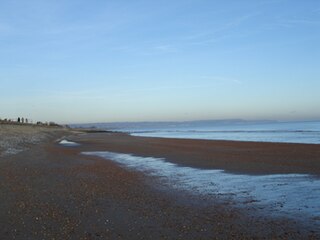
Dymchurch is a village and civil parish in the Folkestone and Hythe district of Kent, England. The village is located on the coast five miles (8 km) south-west of Hythe, and on the Romney Marsh.
Pilton Yard, in Barnstaple was, between 1898 and 1935, the main depot and operating centre of the Lynton and Barnstaple Railway ('L&B'), a narrow gauge line that ran through Exmoor from Barnstaple to Lynton and Lynmouth in north Devon, England. Pilton station was served by regular passenger services advertised between 1898 and 1904 after which only goods facilities were provided. Passengers were catered for at the nearby LSWR station, Barnstaple Town, which provided connections with trains on the standard gauge branch line to Ilfracombe. The L&B's main offices were also based at Pilton, in a building formerly belonging to the Tannery which had earlier occupied the site, and which took over the site after the railway closed.
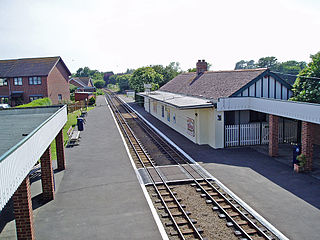
Dymchurch railway station is on the Romney, Hythe and Dymchurch Railway in Kent, England. It is five miles south of Hythe, and surrounded by flat countryside.

St. Mary's Bay railway station is a small station in St Mary's Bay, Kent, England, between the larger stations of New Romney and Dymchurch, on the Romney, Hythe and Dymchurch Railway.

Burmarsh Road railway station is a station on the Romney, Hythe and Dymchurch Railway in Kent, England. It is four miles south of Hythe.

St Mary's Bay, also known as The Bay, is a coastal village in Kent, England. Situated on Romney Marsh, St Mary's Bay has a long sandy beach which stretches north to Dymchurch and south to Littlestone-on-Sea. It has a station on the Romney, Hythe and Dymchurch Railway.
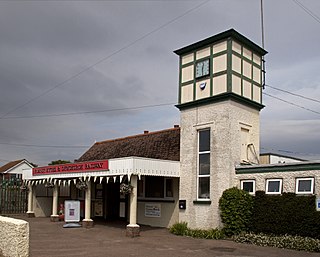
New Romney railway station is a station on the Romney, Hythe and Dymchurch Railway in New Romney, Kent, England. It has always been the headquarters location of the railway.
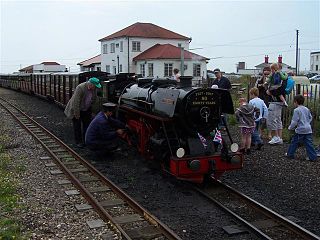
Dungeness railway station is a station on the Romney, Hythe and Dymchurch Railway on Romney Marsh in Kent.

The Pilot Inn railway station was a station on the Romney, Hythe and Dymchurch Railway in Kent, England.
Prince of Wales Halt railway station was a short-lived station on the Romney, Hythe and Dymchurch Railway in Kent, England.

Botolphs Bridge Halt railway station was a little-used station on the Romney, Hythe and Dymchurch Railway in Kent, England.

The War Department halt was an informal railway station on the Romney, Hythe and Dymchurch Railway in Kent, England. Over the 15 years that the station was open, its location is believed to have moved several times. Details are scarce as this was a secret military installation, but the end of the War Department branch line moved as building work moved onto new stages. When the installation closed in 1945 the railway company took over the line for freight shipment of ballast. Again, the end point of the line changed several times as the exact location of extraction of ballast changed, until closure of the branch in 1951. The locations of the halt are now under water owing to subsequent commercial extractions and flooding of the ballast pits.
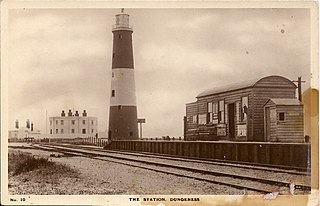
Dungeness was a railway station which served the Dungeness headland in Kent, England. Opened in 1883 by The Lydd Railway Company, it closed to passengers in 1937. Part of the line which served the station is converted to the main access road as a means of transporting atomic waste from nearby Dungeness nuclear power station.

This article gives details of the locomotives used on the Ravenglass and Eskdale Railway, a 15 in narrow gauge preserved railway line running for 7 miles (11 km) from Ravenglass on the Cumbrian coast to Dalegarth near the village of Boot, in Eskdale.

New Romney and Littlestone-on-Sea was a railway station which lay in between the villages of New Romney and Littlestone-on-Sea in Kent, England. The station opened in 1884 and closed in 1967.

Broadmeadow Locomotive Depot was a large locomotive depot consisting of two roundhouse buildings and associated facilities constructed by the New South Wales Government Railways adjacent to the marshalling yard on the Main Northern line at Broadmeadow. Construction of the locomotive depot at Broadmeadow commenced in 1923 to replace the existing crowded loco sheds at Woodville Junction at Hamilton, with the depot opening in March 1924. It was added to the New South Wales State Heritage Register on 2 April 1999.

Romney, Hythe and Dymchurch Railway (RH&DR) locomotive No.1 Green Goddess is a 4-6-2 steam locomotive build by Davey Paxman & Co. in 1925 and was given the works number 15469. It was one of two original locomotives ordered by Captain Howey and Count Louis Zborowski in 1924 and was completed and operational the following year, two years before the RH&DR was completed. The design was based on Sir Nigel Gresley's A1 class which is the class Flying Scotsman belongs to. Its livery was also based on that of Flying Scotsman. The designing of the locomotive was done by Henry Greenly and the total cost of building it was £1,250, or around £79,800 in 2021. While on trail at the Ravenglass and Eskdale Railway the locomotive comfortably achieved a top running speed of 35mph. Although, due to wear on the vale gear and maintenance costs, a regular running speed limit of 25mph is observed. During the later half of the 2023 running season, a Stanier 'hooter' style whistle was fitted - a gift from a friend of the railway.



























